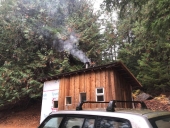So just to be clear:
I am using the term bell 1 to describe the barrel radiator.
I am using the term bell 2 to describe the brick bell.
In my first post, I wrote "Obviously one wouldn't use it in the burn chamber or riser or anywhere near the top of a first brick bell". Note the term "a first brick bell", which is a hypothetical first brick bell because my bell 1 is a barrel radiator.
So sticking with those terms, let me ask my question a little differently.
Considering that most of the heat will be emitted through bell 1 (the barrel radiator), and that the temps entering bell 2 (the brick bell) will be below 100 degrees C, and that the burn box in this design will be made from ceramic fibre board...
...will portland cement fail if used for all the brick-work?
Judging from your reply, Thomas, where you said "Indeed, you can use portland far enough away from the high heat areas", I think my question is answered. Many thanks.










